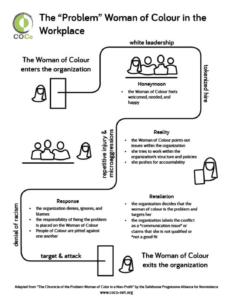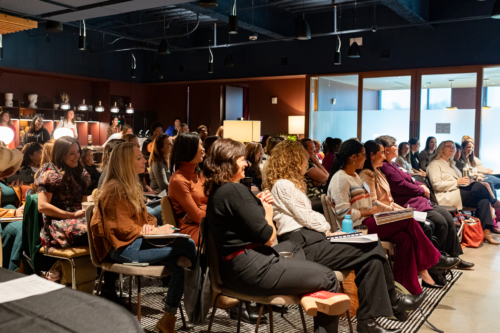From Barriers to Breakthroughs: Empowering Latinas to Lead with Confidence
By Dr. Violeta Garcia, Founder, Ecosistema Design LLC

Hispanic Heritage Month—what I prefer to call Latiné Heritage Month*—is a time to celebrate the rich tapestry of cultures, traditions, and contributions of these cultural groups in the United States. It is a moment to recognize our collective resilience and creativity while reflecting on the ongoing barriers we face, especially when it comes to executive leadership.
The underrepresentation of Latinas in executive positions is not just a statistic but a lived reality for many of us. While Latinas are making progress in the workforce, only about 1.4% of C-Suite roles are held by Latinas, and women of color as a whole occupy a mere 7% of these leadership roles. We face unique challenges shaped by cultural expectations, societal pressures, and, at times, our own internalized doubts. But the good news is that we have the power to overcome these barriers.
Coaching has become a critical tool for first-time Latina executives to break through both internal and external barriers. It empowers us to stand tall in our strength, embrace our cultural assets, and unleash our full potential as the jefas we were always meant to be.
The Latina Executive Experience: Internal and External Barriers
The path to leadership is difficult for everyone, but Latinas face additional challenges that stem from both societal structures and deeply ingrained cultural beliefs. These barriers often affect our sense of belonging and self-confidence as we step into executive roles.
Imposter Syndrome:
One of the most pervasive challenges Latinas face in leadership is imposter syndrome—the persistent feeling of inadequacy despite our achievements. This doubt is especially common in spaces where we don’t see many other women who look like us. We often question whether we belong in the room, doubting our worth despite clear evidence of our success. Latinas have historically been excluded from leadership, and once we enter these roles we might be perceived as a “problem” and eventually exit or get pushed out of the system.

Marianismo:
Marianismo is a cultural belief rooted in the veneration of the Virgin Mary. It emphasizes virtues like self-sacrifice, humility, and purity, and while these values can foster strong community ties, they can also hinder professional growth. Marianismo teaches us to serve others before ourselves, to be modest, and to avoid being assertive. These beliefs conflict with the demands of leadership, which require us to advocate for ourselves, negotiate confidently, and take ownership of our power.
Double Jeopardy:
As Latinas, we often navigate a unique form of compounded discrimination, sometimes called “double jeopardy,” where both our gender and ethnicity come into play. We are underrepresented in leadership roles and often face biases that impact both our professional opportunities and how we’re perceived in the workplace.
Microaggressions:
Latinas often experience microaggressions in professional settings. These are subtle, sometimes unconscious, forms of discrimination—such as a comment about our “fiery” personality or assumptions about our capabilities—that undermine our confidence. Over time, these constant jabs can create a sense of isolation and alienation in spaces where we already feel like outsiders.
Lack of Role Models:
The scarcity of Latinas in executive positions exacerbates these challenges. Without seeing other Latinas in leadership, it’s easy to internalize the message that these roles are out of reach. The absence of mentors who understand our specific challenges can make the journey to leadership feel even more daunting.
Cultural Assets: Strengths Latinas Bring to Leadership
Despite these obstacles, Latinas bring a wealth of cultural assets that make us well-suited for executive leadership. The same qualities that may have been undervalued in traditional corporate spaces are exactly the strengths we need to thrive.
Resilience:
Latinas have a long history of overcoming adversity. Whether it’s navigating complex immigration systems, economic hardships, or discrimination, we know how to rise above challenges. This resilience is a key leadership trait, allowing us to handle crises with grace and perseverance.
Strong Work Ethic:
The value of hard work is ingrained in many Latino families. We’ve been taught to push through obstacles, work diligently, and strive for excellence in everything we do. This drive and determination make Latinas effective leaders, especially in environments that require grit and persistence.
Communal Focus:
Latina culture often emphasizes family and community, which translates into a leadership style centered on collaboration and collective success. We understand the importance of lifting others as we rise and creating inclusive environments where everyone can thrive.
Cultural Fluency:
Many Latinas are multilingual and culturally fluent, allowing us to navigate diverse markets and teams effectively. In an increasingly globalized world, this ability to bridge different cultures is an invaluable asset in leadership.
Cultural Barriers: Traditions to Navigate
While our cultural heritage offers many strengths, some traditions may hold us back in leadership roles.
Machismo:
Machismo is a belief system that emphasizes male dominance and can create a lack of support for Latinas aspiring to leadership positions. In some families or workplaces, women who step into powerful roles may face resistance, as they are expected to adhere to traditional gender norms.
Emphasis on Family:
Latinas are often expected to prioritize family above all else, and while this value can create strong familial bonds, it can also complicate the demands of an executive role. Balancing a leadership position with family responsibilities can feel overwhelming, but finding ways to integrate family into our leadership journey can strengthen relationships and set a positive example.
Coaching: The Key to Unlocking Latina Potential
This is where coaching comes in. Coaching offers a space for Latinas to explore these cultural dynamics, confront internal barriers, and develop strategies to thrive in leadership roles. A coach can help us:
Challenge Imposter Syndrome:
Coaching allows Latinas to identify and dismantle negative self-talk, replacing it with a deep sense of self-worth and confidence. A good coach helps us see that we do belong and that our voices and perspectives are valuable.
Navigate Marianismo:
A culturally aware coach understands the pressures associated with Marianismo and helps Latinas redefine ambition and assertiveness as positive qualities. We can honor our cultural roots without sacrificing our professional aspirations.
Build Leadership Skills:
Coaching helps Latinas hone key leadership skills, including communication, decision-making, and delegation. These are critical tools for stepping into executive roles with confidence.
Connect with Role Models:
Coaches can also provide access to networks and mentors, helping Latinas find role models who understand their unique challenges and can offer guidance and support.
Breaking Free and Paving A New Path
The journey to becoming a Latina executive is not just about breaking through external barriers but also about overcoming the internal narratives that hold us back. By acknowledging our strengths, embracing coaching, and leveraging our cultural assets, we can take on executive roles with confidence and grace.
As we rise, we have the responsibility to reach back and uplift other Latinas on the same path. Together, we are not just breaking glass ceilings—we are building a legacy of leadership that empowers our entire community.
At Ecosistema Design, we believe in the power of coaching to transform lives and leadership journeys. Let’s celebrate Latiné Heritage Month by embracing our cultural strengths, seeking out the support we need, and leading with confidence. We have everything it takes to succeed, and when one Latina rises, we all rise.
*A Note on Terms
The terms Hispanic, Latino, Latinx, Latiné, and Latin America are often used interchangeably, but they have different meanings that reflect the complexity of cultural, ethnic, and geographic identities. Learn more about the history here.
1. Hispanic
- Definition: Refers to people, cultures, or countries with a historical link to Spain, particularly Spanish-speaking countries. This term was created during the Nixon administration and used in the 1980s census to group people from Mexico and Puerto Rico into a common category.
- Geography: This includes Spain and most of Latin America (except Brazil), and it excludes non-Spanish-speaking areas of Latin America like Brazil, Haiti, and other countries.
- Focus: Language and cultural connection to Spain.
2. Latino/Latina
- Definition: Refers to people from Latin America, regardless of language. This includes Spanish-speaking countries as well as Portuguese-speaking Brazil and French-speaking Haiti.
- Geography: Encompasses all of Latin America, from Mexico down to Argentina and the Caribbean (such as Puerto Rico, Cuba, and the Dominican Republic).
- Focus: Geography and shared Latin American heritage, not just the Spanish language.
3. Latinx
- Definition: A gender-neutral alternative to Latino/Latina that emerged in the early 2000s, primarily used in the U.S., to be inclusive of people who don’t identify as strictly male (Latino) or female (Latina).
- Use: Mostly in academic, social justice, and younger circles in the U.S. as a more inclusive term. It can be controversial, as some people feel it’s not reflective of Spanish language norms because “x” is not a common letter in the language.
4. Latiné
- Definition: Another gender-neutral term that, unlike Latinx, aligns more closely with Spanish grammar by using “é” instead of “x.” It is gaining popularity in some Spanish-speaking communities for being more phonetically natural while maintaining inclusivity.
- Use: More common among Spanish speakers and those who find Latinx unnatural or difficult to pronounce.
5. Latin American
- Definition: Refers to people from Latin American countries, regardless of the specific language they speak. It encompasses individuals from the entire Latin American region, which includes Spanish, Portuguese, and French-speaking countries in Central America, South America, and the Caribbean.
- Identity: Focuses on shared cultural, historical, and geographic roots from Latin America. A Latin American can be someone from Mexico, Brazil, Argentina, Cuba, or Haiti, among others.
Should we call it Hispanic Heritage Month or Latino/é Heritage Month?
- Hispanic Heritage Month (officially recognized as such in the U.S.) has traditionally focused on honoring the contributions of people with Spanish-speaking backgrounds, tying into the broader U.S. history of recognizing Hispanic culture.
- Latino Heritage Month would expand the scope to include all people from Latin America, regardless of their language (including Brazilians and Haitians).
- In recent years, there has been a growing movement to rename it Latino Heritage Month (or even Latinx/Latiné Heritage Month) to be more inclusive of non-Spanish-speaking Latin Americans.
The terms can serve different purposes depending on the context. “Hispanic Heritage Month” centers around Spanish-speaking countries and was developed by the United States to group people of Spanish origin or who spoke Spanish, while “Latiné Heritage Month” could be more inclusive of all Latin American countries, regardless of language and of gender identity. As the conversation about inclusivity grows, so does the consideration of what the most appropriate term is for this celebration.





